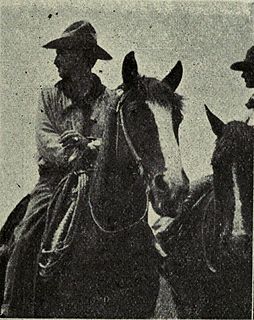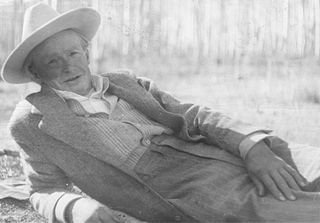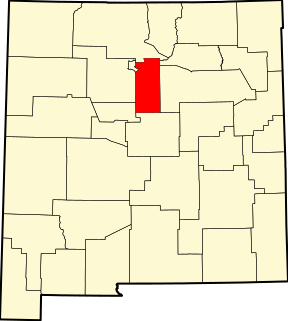Related Research Articles

Mary Hunter Austin was an American writer. One of the early nature writers of the American Southwest, her classic The Land of Little Rain (1903) describes the fauna, flora, and people – as well as evoking the mysticism and spirituality – of the region between the High Sierra and the Mojave Desert of southern California.

Monterey State Historic Park is a historic state park in Monterey, California. It includes part or all of the Monterey Old Town Historic District, a historic district that includes 17 contributing buildings and was declared a National Historic Landmark in 1970. The grounds include California's first theatre, and the Monterey Custom House, where the American flag was first raised over California.
Rollie Lynn Riggs was an American author, poet, playwright and screenwriter. His 1931 play Green Grow The Lilacs was adapted into the landmark 1943 musical Oklahoma!.

The Camino Real de Tierra Adentro was a Spanish 2,560-kilometre-long (1,590 mi) road between Mexico City and San Juan Pueblo, New Mexico, USA, that was used from 1598 to 1882. It was the northernmost of the four major "royal roads" that linked Mexico City to its major tributaries during and after the Spanish colonial era.
Alice Corbin Henderson was an American poet, author and poetry editor.
Jozef Bakos (1891–1977) was an American painter best known for his Western landscapes.

The Santa Fe Plaza is a National Historic Landmark in downtown Santa Fe, New Mexico in the style of traditional Spanish-American colonial cities. The plaza, or city square, was originally, and is still to this day, the center gathering place in town. Many know it as "the heart of Santa Fe". The landmark has since grown into a playground for many tourists interested in Spanish, Native American, and Mexican cultures, and includes music, design, jewelry, art and dance. It is home to annual events including Fiestas de Santa Fe, the Spanish Market, the Santa Fe Bandstand, and the Santa Fe Indian Market.

William Penhallow Henderson was an American painter, architect, and furniture designer.

Andrew Michael Dasburg was an American modernist painter and "one of America's leading early exponents of cubism".

The National Park Service Southwest Regional Office, also known as National Park Service Region III Headquarters Building, is located at 1100 Old Santa Fe Trail in Santa Fe, New Mexico. The office provides support services for Park Service properties throughout the intermountain region of the American Southwest. The building, designed by NPS architect Cecil J. Doty, it is a traditional adobe building, built the 1930s by crews of the Civilian Conservation Corps. It is the largest adobe office building in the nation, and a masterpiece of Spanish Pueblo Revival architecture. It was designated a National Historic Landmark in 1987. It is open to the public during normal business hours; tours are not normally given.

Seton Village is a National Historic Landmark District in a rural residential area south of Santa Fe in Santa Fe County, New Mexico, United States. It encompasses a residential settlement and educational facility established in 1930 by Ernest Thompson Seton (1860-1946), an educator and conservationist best known as a founder of the Boy Scouts of America. The district includes the remains of Seton's 32-room home and other residential and educational buildings constructed mostly between 1930 and 1945. It was declared a National Historic Landmark in 1965.

This is a list of the National Register of Historic Places listings in Santa Fe County, New Mexico.
Santa Fe Public Schools (SFPS) is a school district based in Santa Fe, New Mexico. Santa Fe Public Schools serves the city of Santa Fe, the communities of Tesuque and Eldorado, and the historic neighborhood of Agua Fria, and other communities with a total area of 1,016 square miles (2,630 km2). The school district has a total of 31 schools: three high schools, three combined high/middle schools, three middle schools, and 21 elementary schools.

Monte del Sol Charter is a public charter high school in Santa Fe, New Mexico. As of 2017, the school had 353 students and 25 classroom teachers.
Alfred Gwynne Morang (1901–1958) was an American painter, author, art critic and active member of the Santa Fe art colony.
Willard Nash was an American artist best known for being a member of Los Cinco Pintores.

The Santa Fe art colony was an art colony in Santa Fe, New Mexico which developed in the early 1900s.

The Camino del Monte Sol Historic District, in Santa Fe, New Mexico, is a 52.1 acres (21.1 ha) historic district which was listed on the National Register of Historic Places in 1988. The listing included 106 contributing buildings.
The Camino Real in New Mexico was the northern part of a historic roadway known as the Camino Real de Tierra Adentro that from 1598 ran from Mexico City northward through central and northern Mexico and the Trans-Pecos part of what is now Texas to San Juan Pueblo in Santa Fe de Nuevo Mexico, now the state of New Mexico.
References
- 1 2 "Garcia-Stevenson House" . Retrieved July 8, 2019.
- ↑ Corinne P. Sze (February 12, 1988). "National Register of Historic Places Registration: Camino del Monte Sol Historic District". National Park Service . Retrieved July 8, 2019. With accompanying 30 photos